Another one possession loss and blown lead for the Irish in 2016. What do all these one possession losses mean for the team’s future, and why is the offense always stalling out in the second half?
Confused? Check out the advanced-stats glossary here.
This week we’ll review what went wrong in the second half against the Hokies and then talk a little bit about what all these close losses mean for Brian Kelly and this team’s hopes in 2017.
Explosiveness
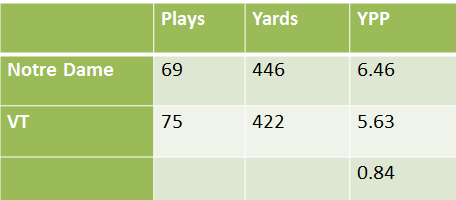
Zoom all the way out what you experienced on Saturday and this looks like a very strong performance by the Irish offense against a strong Hokie defense. It was wholly unsatisfying because of the sequence of events that unfolded, but 31 points against Virginia Tech was a reasonable number to expect a win out of – going back to the concept of percentile rankings from the preview, this was an offensive performance in the 83rd percentile.
There seems to be a growing idea that Brian Kelly and the three-headed offensive play-calling consortium can’t make adjustments or call plays well after the opening “scripted” sequences end. The Notre Dame offense has been excellent in the 1st Quarter (3rd nationally in Q1 S&P+) and then things have gotten very trashy – 58th in Q2, 59th in Q3, and 77th in Q4.
While I agree that play-calling has been subpar for the year – Kelly on Sunday admitted it’s an area for him to re-evaluate this offseason – I think it’s been over-used as an explanation for the offenses struggles. I don’t think the play-calling has changed dramatically as the game has gone on as much as a young team without much quality depth has struggled to execute and respond well to the unfamiliar.
For example, last season, with the same triumvirate calling plays, the Irish offense was 1st in Q3 Offensive S&P+ and 2nd in the Q4. Have Denbrock, Kelly, and Sanford totally lost their mojo, or are fatigue, youth, and inexperience a much larger culprit than is being recognized? None of this excuses the coaching staff by the way – the fact that this team is young and without quality depth all goes back to the head coach. But diagnosing second half issues as play-calling is overly simplistic and ignores the personnel gaps this team is trying (and at this point unable) to overcome.

Defensively, I think this was a worse performance on film than on paper. After some bright spots against Miami and hope that against a non-option opponent maybe a corner had been turned, the secondary was shredded by a decent passing team. The ND defense hasn’t seen many of those this year, and it’s only going to get worse next week in the Coliseum.
Taking a closer look, the Irish really struggled to stop Virginia Tech when the Hokies weren’t shooting themselves in the foot. After a nice first possession by the defense forced a turnover off a well-timed Onwualu blitz that caused a Jerod Evans fumble, basically all other stalled drives involved a bad snap, penalties, or a fumble by the VT offense.
Even the Tranquill interception was off a very catchable ball that could have gone for a huge gain. Justin Fuente also chose to kick the ball on 4th and 2 from the Irish 4, 4th and goal from the 2, and 4th and 1 from the Irish 40-yard line when a conversion would have won the game. It’s a unit that has improved in the post-BVG era but still struggles to defend the pass without many real pass-rushing threats and secondary comprised mostly of true freshmen.
Efficiency

Let’s talk some more about second half struggles! As I wrote about in last Friday’s preview, the Hokies defense is one of the best in the nation on passing downs, so limiting those situations would be key. Kizer and company did a great job in the first half avoiding too 3rd and long situations and made excellent plays to convert a 3rd and 10 outside the red zone and a 3rd and 15.
But it wasn’t surprising when things regressed back to expectations in the second half – the first two drives featured false starts that immediately put the ND offense in early passing downs. A key 4th quarter drive was put way off course by a Folston rush that lost four yards. Mistakes played right back into the hands of Virginia Tech’s defense, and it really wasn’t a fair expectation for the offense to convert numerous 3rd and 13+ situations (which happened three times in the second half).

The officiating on Saturday was some awful garbage, even by ACC standards, but I think the first non-targeting call on DeShone Kizer was the most impactful in the game. All season long mobile quarterbacks have been Virginia Tech’s biggest weakness on defense, and in the first half Kizer exploited that with 9 carries for 47 yards. Six of those were successful plays, and it also likely helped open things up for the running backs and play-action.
After taking the first big hit to the head early in the 3rd quarter, Kizer ran only four more times in the game – and two of those carries came on the final drive. I think the play had a huge impact on Kizer and Notre Dame’s game plan, and there was nothing done to protect him on that play (way to go, clowns on the field and in the booth).
Field Position
Average Starting Field Position
Notre Dame: Irish 24
Virginia Tech: Hokies 35
There weren’t any special teams miscues of epic proportions in this game, but the Hokies had sustained field position advantages despite two turnovers. More than half of Tech’s drives started at their own 39-yard line or better, which spelled doom for a defense that needed as long a field as possible to work with. Tyler Newsome was pretty wind-dependent and unfortunately was facing the wrong direction on key fourth quarter punts.
Finishing Drives

After scoring on their first three possession of the first half, the Irish only made it past the Hokie 40-yard line once in the second half. The early field goal when Notre Dame had first and goal from the 2-yard line was painful at the time and especially later as the lead evaporated. I don’t give much credit to the defense, as the Hokies likely could have scored a touchdown or two more if Fuente hadn’t played it somewhat conservatively in the second half and settled for a couple field goals.
Turnovers
Brian Kelly entered this season undefeated when Notre Dame doesn’t turn the ball over and has now lost two of his last three games in that fashion. Virginia Tech fumbles as much as anyone in the nation, but unfortunately many of those fumbled exchanges and handoffs were recovered by the Hokies. The Irish secondary simply didn’t get their hands on many balls on Saturday, but it was nice to see Tranquill come up with a pick in what’s been a rough season for the junior.
Well, what comes next?
This is obvious, but going 1-7 in one possession games is a sign of a team whose quality is better than their record. The Irish have led or been tied in the 4th quarter of every loss. Notre Dame still has a positive points per game and point differential on the season. They’ve actually won the YPP battle in more games than not. It’s almost impossible to do these things and have this bad a record, which is both encouraging and discouraging at the same time.
If you like advanced stats (and if you’ve made it this far, I assume you at least tolerate them) you may be familiar with Pythagorean expectations or “second-order” wins. Both of these formulas use some not all that complicated math to essentially try to take some randomness and luck out of wins and losses to indicate what a team’s record should be, given the sum of their season stats. It’s been proven over the years to be a strong predictor of year to year changes – if you overachieve your expectation, some regression is expected, but if you underachieve, some definite improvement is probably in the cards.
Even before the USC game (where unless the Irish win, our second-order win margin won’t increase), Notre Dame has a second-order win differential (+2.9). Our season stats would suggest a team with seven wins and four losses – this kind of “underachievement”/ “bad luck”/ “ability to blow close games” (pick your favorite adjective) is pretty remarkable.
Friend of the program Bill Connelly looked at second order wins a couple years ago, and that margin would tie for the fourth highest in all of FBS over a 10-year period (2005-2014). And the track record on the following season on second-order wins has been strong – from the article:
“Of these 35
[biggest FBS underachievers from 2005-2013], four saw their actual win percentage regress the next year, four stayed the same, and 27 improved. Of those 27, 15 improved by at least 20 percent…Of these 32 [biggest FBS overachivers from 2005-2013], two saw their win total improve the next year, two stayed the same, and 28 regressed. Fourteen of those 28 saw their actual win percentage drop by at least 20 percent”
This will be a fairly strong team in 2017 regardless of who the head coach is – this type of season hasn’t repeated itself in recent history.
There are some strong bounce-back examples in that link, including 2013 TCU (+3.2 second order wins compared to a 4-8 record) that made a strong run at the CFP in 2014. Texas A&M in 2011 (+2.4) also makes the list at 7-6 before taking a lead with Johnny Football in 2012 to a top-10 team. If you’re looking for a defense at bringing Kelly back, that’s as good of evidence as you’ll find.
Bringing this back to the hot topic of the week, Brian Kelly’s hot seat, even if this team isn’t as bad as 4-8, it’s still troublesome to regress from a top-10 team in 2015 to a top 30-40 team in 2016. It’s a much higher floor than previous head coaches have achieved, but one that’s still not tolerable at a program with much higher expectations. Especially concerning is the role coaching has played in these losses – from in-game decisions to preparation and Van Gorder-related messes. That second-order win differential can just as easily point to bad luck as it can bungling opportunities in winnable games.
So if BK is not the long-term solution, which looks increasingly likely, losing these close games is helpful accelerating that course. That could take place in Swarbrick and company’s decision this offseason (less likely), or in raising the threshold needed for Kelly to retain his job next season (more likely). Against this weak schedule, this deeply flawed team could still easily have gone 8-4, and then the heat isn’t really turned up to 11 as it deserves to be next season.
If Swarbrick so chooses, there’s enough justification to fire Brian Kelly, the question is if doing it this off-season is the right move. Just as the backup quarterback is the most popular player every year, so is every potential coaching replacement. Does it hinder Notre Dame’s ability to hire the next elite coach if the administration is seen as quick-triggered? To me that’s a real risk –there’s already enough hurdles to overcome in South Bend that don’t exist at similar football powers, and outside the ND bubble I don’t think many coaches or writers believe Kelly should lose his job just yet. Discerning out the emotions of fandom – from the natural desire for vengeance and action following disappointment to simply “I’m tired of this guy” or “ I never liked him” – is why Savvy Jack gets paid the big bucks.
My perspective? I’m good either way. I don’t think Kelly is the long-term answer – beyond the on-paper performance, it has the look of a team that’s disorganized, not fundamentally sound, and as a result is too inconsistent. But outside of 3-4 coaches, I’d rather give Kelly another year than hire Dan Mullen, for example. I understand those who feel differently, but the worst case scenario (which I’m conditioned as a Notre Dame fan to be fearful of) is replacing Kelly this offseason with yet another coach whose ceiling is mediocrity.
So if the right coach isn’t there – and it often takes a combination of luck and timing working out for that to be the case, as Michigan, Ohio State, and Alabama have benefitted from – please don’t go hire Mike Gundy. A year ago we watched Kelly lead an injury-wrecked team to a 10-2 regular season record with narrow losses to top-5 teams. I’m not sure what’s changed this season, but another year to find out if he’s really the guy we saw in 2015 or 2016 isn’t insanity either, and competing with LSU and Texas for top coaching candidates makes Notre Dame at best the 3rd most appealing job if it should open.

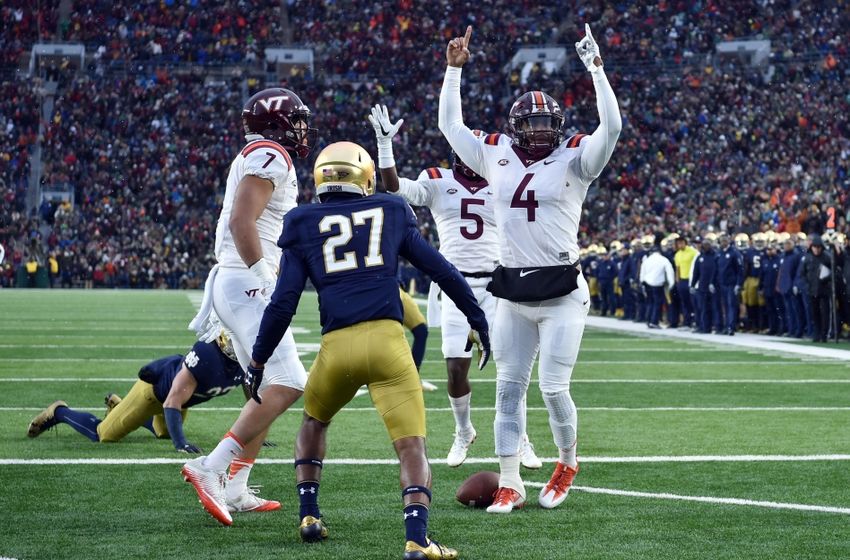
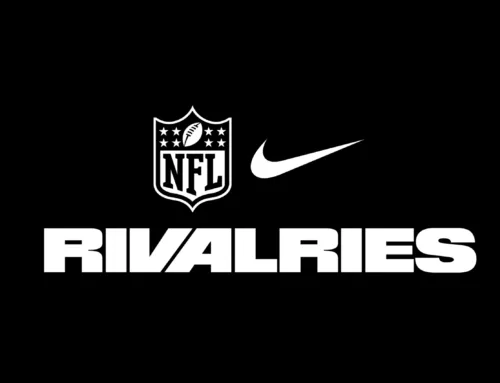
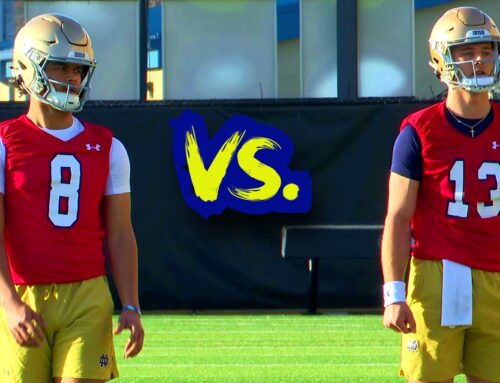
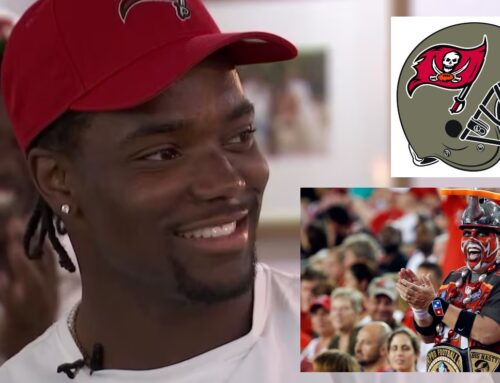
I guess the one bright spot is that I can’t see us not get a new D coordinator (at least). I was worried if the D really improved that Hudson would be kept on.
I had held up hope that we would improve to the point of squeaking in to 6 wins and a bowl. Just a depressing year to witness. Maybe we can surprise USC, but I’m not counting on it.
You mention the second-order wins as a potential reason for keeping Kelly, but I could turn around and argue that it might be a good idea to get the new coach now given that some improvement is almost certain next year given regression + additional experience for a young team. There will (deservedly) be no buzz in the program if the team goes 9-3 next year with Brian Kelly, but there would be if they went 9-3 while Rowing That Boat.
The case for keeping Brian Kelly is that you think he can coach the team to 11-1 or 12-0 next year, basically, and that he can right the ship and stick around for 4-5 more years. That seems quite unlikely, given that there will be a new DC and maybe they will be switching to the 3-4 (not to mention that he has gotten to 11 wins exactly once in 7 years). If they’re changing schemes, they might as well change coaches.
Agree with pretty much everything you said there, although I think 11-1 or 12-0 is a higher than where the bar will be set. The piece you mentioned – that maybe Kelly can right the ship and bring 4-5 years of success more like 2012/2015 and stability – is interesting when looking at the second-order wins. Part of what I was implying with the examples of coaches/programs are that that includes some that rebounded well and seem to be on better trajectories (Patterson at TCU), some have had mixed results (Sumlin at A&M), and others have rebounded but not far enough to save their jobs (you have to go further down the list for many P5 examples, but those include a potpourri of coaches like Houston Nutt, Dennis Franchione, and also Bill Snyder, who is hard to evaluate in short-term periods).
The only thing I’d add is that you mention the challenge with a new DC and potential change in scheme, and putting a new HC in place almost certainly brings even more of those continuity losses as well. I also don’t think the logic follows in terms of changing scheme defensively you might as well change coaches. Kelly’s offenses have been very consistently successful despite challenges at QB (some probably Kelly inflicted), so I don’t think that’s a given that a new coach would be able to sustain that level of success on that side of the ball. That’s the risk and flip side of the coin right? You make the wrong coaching decision and you have potential issues on both sides of the ball, versus potentially keeping what’s working and rectifying the defense with the right hire. I’m not advocating strongly one way or the other, just pointing out that I don’t think it’s a slam dunk that firing Kelly is going to fix the problems with this team/roster, which is an easy trap to fall into right now.
Zero disagreement for me either. I suppose that one way of looking at it is that I think the program would be in a better place going 8-4 with Someone Else as HC than 9-3 with Brian Kelly, because a 9-3 Brian Kelly season will feel stale. I do think changing coaches this year would most likely cost us a win or two next year, but I think that’s an acceptable sacrifice. The best thing for next year would probably be keeping Kelly and minimizing staff changes, but I think that is also probably the worst-case scenario for the program going forward (i.e., 3+ years out).
I do think comparing Nutt, Franchione (non-Bama-gigs), and Snyder to Kelly is pretty unfair to the three; Arkansas/Ole Miss, A&M, and (especially) Kansas State are not the Notre Dame job.
Very true. The 3+ years out is exactly the most important thing, which is why I (and I believe Eric is writing up something on this as well) think nailing the next HC decision is much more important than firing Kelly this offseason or not. It seems pretty unlikely BK is leading this team out of the tunnel in’18 saving a double-digit win season, and per usual there aren’t many gimme games on next years schedule (hell the home opener at Temple scares me, much less UGA/Michigan State/UNC/Miami again on top of the usual rivalry games), and maybe after next week even less likely that he does in ’17.
The comparisons to the three HCs you mentioned wasn’t equating the expectations to the ND job, but pointing out that while second order wins should lead to a rebound the next year, it still may not get you to expectations, whatever they are at that respective school. Snyder is impossible to evaluate because of his longevity – his early work to get K-State to a respectable program and even competing for conference titles is as impressive as any HC’s work, then he hit some big-time lulls (but would never get fired because of his earlier work), and then some great years again at the start of this decade.
So… “Rowing That Boat”… is that a tongue-in-cheek reference to PJ Fleck or an actual endorsement? He seems to have that Lou Holtz-ian “motivator” approach to coaching which looks a little more appealing every time we lose.
Just for fun, how deep in over his head do you think Fleck would be jumping from WMU to ND? Or do you think it’d be a manageable transition?
I think Fleck is the most likely non-Brian Kelly coach for ND next year, as a matter of practicality. I think there are some other guys who might fit better (and obviously there are the dream candidates), but ultimately I’d rather Fleck be the HC next year than Kelly if those are the options.
As to your latter question, I really have no idea. But it seems like it would be a welcome breath of fresh air to have an upbeat, likable coach.
I like Fleck a lot, but he’s about as unproven as it gets in terms of the other realistic coaching candidates. He’s done nice things in 4 years at WMU but prior had no experience as a coordinator. It seems like a slam dunk that he would do well as a recruiter – he’s pretty much blown the rest of the MAC out of the water on that front – but definitely seems to be more motivator/program shaper than tactician. But we saw the importance of making good staff hires with BK – does Fleck have the connections to pull in a great DC? Are the coordinators he currently has good enough to make the jump from the MAC to trying to compete for a playoff? No one really knows.
I don’t mind the gamble – he’d probably be in my top 3 realistic candidates if I could pick – but I think Swarbrick and the administration might. He’s done a lot to attract attention to WMU, which makes total sense, but it’d be a totally different strategy at ND where you’re already under the microscope. Things like how he started his career at WMU, pulling schollies from verbal commits during the dead period so they would have to commit again to the new coaching staff, would blow up in a way it definitely didn’t in Kalamazoo. I love his energy and passion, but it’d take one loss to Temple or Navy before some fans/media get tired of his “act” and start complaining he’s all style and no substance, “small timey”, etc.
So yeah, I think it’d be a bit of a rocky transition, but could it be worth the upside? Maybe. I just think Swarbrick is the type who’d compare four years of MAC HC experience to someone like Mike MacIntyre who has led turnarounds at two stops including a P5 job (or even Willie Taggart) and feel more comfortable with a slightly longer resume.
“The Irish have led or been tied in the 4th quarter of every loss.”
Not in the MSU game.
Ah good catch, thanks. Saw that from a beat writer on Twitter and it seemed accurate at first glance, but you’re right, that is the one exception.